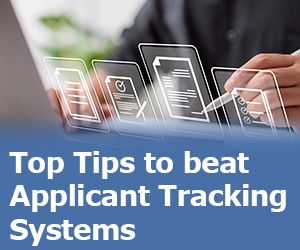Make Applicant Tracking Systems work for you
Category: Tips and Advice
Publish date: 03/05/2023
 This month we'd like to shed some light on Applicant Tracking Systems and how you can beat them.
This month we'd like to shed some light on Applicant Tracking Systems and how you can beat them.
Applicant Tracking Systems (ATS) are increasingly being used by organisations of all sizes to manage and administer the application process; and it’s highly likely that your job application will be reviewed by one of these systems before it reaches a human reader. So it's important you understand the key criteria that your applications should meet in order to give yourself the best chance of success in the civilian market.
1. Use the job advert to identify key responsibilities of the role To ensure you're ticking all the right boxes, you'll want to make sure you use much of the same language used in the job description within your application. Job adverts will often outline the main experience and skills the hiring organisation is looking for in a candidate, and so you'll want to identify and reference these in your own documentation; remembering that many of the skills acquired during Service are transferable to civilian roles. Plus, you can use the Job Matching Toolkit, found in the CV and Application Form Guide, to help you pick these details out.
2. Utilise keywords throughout If you study them closely enough, job adverts will reveal keywords associated with the role that ATS's will be scanning all applications for. Once you've identified which skills, responsibilities or experience requirements are being highlighted as essential for the job, be sure to use these keywords or phrases between two and three times within your experience section to showcase your suitability as a candidate. And don’t forget to utilise WordCloud generators such as Tag Crowd to check that you’re hitting the right level of keywords.
3. Proofread your application Sounds obvious, but ATS's are looking for specific and correctly spelled keywords and phrases in order to identify suitable candidates. If you've misspelt any of these within your application, the ATS won't recognise them and you'll miss an opportunity to score well against the key criteria for the role. So, always take the time to proofread your application, or get someone else to do so if possible, prior to submitting, and use the myCV tool in myCareerPath to have your CV examined for suggested improvements.
4. Balance the needs of the ATS with those of the human reader You need to remember that a human will eventually read your application as well. It's no good just stuffing your application with keywords in order to beat the ATS, as a human reader will immediately see what you've done and discredit your application. You'll also want to implement clear headings and bullet points to ensure your application is easy to read - an ATS won't care too much for layout, but a human reader will – so make their job easier by using proper formatting. Remember to utilise your Career Consultant here, as they’ll be more than happy to support in reviewing your applications too.
When transitioning from the military, applying for new roles can feel like a job in itself sometimes. Which is why we want you to be as efficient as possible in your application process. If you need any further guidance on how to overcome Applicant Tracking Systems, there are a number of additional videos in myCareerPath that cover this aspect of your CV development.